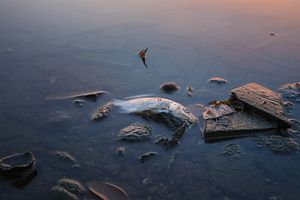In addition to the off-shore conflict in the South China Sea, Vietnamese citizens now have to face another disaster on the country’s central coast. Unprecedented fish kills have been discovered along the beaches of four central coastal provinces, namely Ha Tinh, Quang Tri, Quang Binh, and Hue. Among the dead fish are not only small, shallow water fish, but also rare species living in deep water and far offshore.
Vnexpress, a Vietnamese news agency, cited the Vietnam Directorate of Fisheries as saying that “The total loss reached 4.7 billion dong (around $200,000) in less than one week, including 37,200 brood fish, 900,000 brood shrimps, and 200,000 brood clams in Ha Tinh Province. Hue also lost 5,900 brood fishes.”
Then, on April 24, a 100 kg whale was also found dead on the coast of Hue Province. According to the coastal citizens, this is an abnormal phenomenon, since previously discovered dead whales had been much larger and presumably died from old age. Locals are concerned that this small whale also died from poisoned water, along with the other fish in the mass fish kills along the central coast this month. This raised alarm among the citizens since it offered proof of the massive extent of the poisoned area.
Never in their life have local fishermen caught fish so easily and in such a great amount, and yet felt so frustrated and desperate. No one dares to eat the fish. Some who tried have already had to go the hospital.
On April 26, five divers with the Nibelc company, a construction company contract by Hung Nghiep Formosa Ha Tinh Steel Corp (an offshoot of the Taiwan-based Formosa Plastics Group) had to be hospitalized suspiciously, allegedly due to pollution dumped by Formosa industrial site into the sea water in Ha Tinh. Previously, on April 24, Le Van Ngay, another Nibelc diver, died after diving in the water near the Formosa project.
While the government has been slow in responding and investigating the fish deaths, the citizens and reporters of VTV, together with the Investigation Center of Ha Tinh, conducted a public experiment with the polluted sea water. The experiment observed two normal, living fish dying within two minutes of swimming in the water sample. The first official conclusion from the Vietnam Ministry of Agriculture and Rural Development was that the cause of the fish kill was not contagious disease but poisoned water. However, there have been no announcement as to what could have tainted the water.
Local fishermen have been observing the dumping process of Formosa’s steel plant in Ha Tinh province. The fishermen found out about the existence of an undersea dumping pipeline two years ago, but the dumping was not noticeable. According to their accounts, this year there was suddenly a huge amount of discharge, visible in the form of a red water column near the pipes. After that, the mass fish kill appeared across all four central coastal provinces.
An investigation is still underway, and a Vietnamese official cautioned that there is no proof linking Formosa to the fish deaths. However, Formosa has drawn fire for the blunt words of Chu Xuan Pham, the director of the company’s local external relations department. In an interview with VTC on April 25, he said: “Before acquiring the land, we already advised local fishermen to change their jobs. Despite our early recommendation, local fishermen kept on fishing in this area. Many times in life, people have to make a choice: either to catch and sell fish, or to develop the steel industry. We cannot have both.”
What an attitude! Formosa publicly announced they had invested $45 million in the dumping system. Based on the comment from Formosa’s representative, the investors believe that they have already paid their money and now are free to “develop” however they want. Chu later apologized for his comment, but the damage was done.
Making things worse, it seemed like Formosa, a multi-national corporation, had elevated itself even above the Vietnamese government. At the beginning, state-assigned inspectors were forbidden from entering the Formosa’s land, based on concerns about confidentiality. Only after the reporters and citizens raised concerns did Formosa allow the inspectors to take the samples for testing.
Looking back at Formosa’s record on environmental issues, perhaps it’s not surprising that 30 tons of fish have died in one week in Vietnam. In 2009, the Formosa Plastics Group “won” the Black Planet award, a negative “award” issued by the German foundation Ethecon to individuals and companies engaging in environmental destruction (a fellow “winner” is Monsanto, which, along with Dow Chemical, manufactured the infamous Agent Orange). While making a great contribution to the industrialization and economic development of Taiwan, Formosa Plastics Group has also earned a bad reputation for harming the environment. In the United States, in Texas and Louisiana, Formosa factories were found to have dumped toxins into the land and groundwater, and even the Mississippi River. In 2009, Formosa was fined $2.8 million dollars by the EPA to resolve environmental problems in Texas and Louisiana.
In 1998, Formosa Plastic dumped 3,000 tons of waste (containing mercury) in in Sihanoukville, Cambodia. When residents fell ill (five later died), it sparked riots. Roughly 1,000 citizens fled their homes and marched on Phnom Penh. The Cambodian government later sued Formosa for bribing the local government with $4 million to be allowed to dump the waste; 30 local officials were forced to resign.
A similar situation seems to be repeating in Vietnam. It has been almost one month since the first fish deaths, but the government has been slow to react and there seem to be no signs of an effective solution.
































